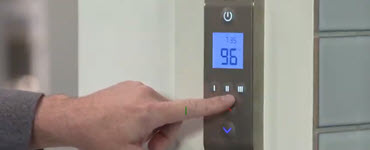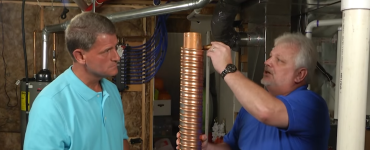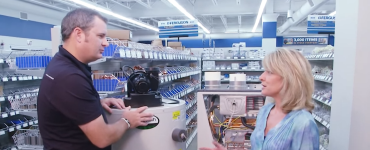Tricks for saving water and energy
Save energy and water around the house
Water conservation in the home
Shower power
Easy water and energy saving tips
Setting the thermostat
One of the easiest ways to reduce your energy costs is to lower the water heater thermostat - for every degree it's set back, you'll save one percent.
Before you reach for the dial, keep these tips in mind:
- Don't set the thermostat lower than 120 degrees. Water temperatures below this point allow unhealthy bacteria to develop.
- If you have small children, never set the thermostat higher than 120 degrees. Temperatures above 110 degrees can quickly scald a child, so it's a good idea to invest in "anti-scald" faucets. Never let small children turn on hot water faucets by themselves.
- If you go on vacation for more than three days, turn the thermostat down to low. If you have a natural gas water heater, don't shut it off completely - you'll need to relight the pilot light, and that might take a service call from a technician. When you return, allow several hours to let the water reach 120 degrees before using.
In the bathroom
- Switch to a low-flow showerhead. You'll save three to five gallons per minute.
- Install aerators on the sink faucet.
In the kitchen
- If you have an automatic dishwasher, wash only full loads, let dishes air-dry, and use the "energy-saver" cycle as often as possible.
- Use cold water to run the garbage disposal - it helps solidify grease.
- Install an aerator on your kitchen faucet.
- If you have a leaky hot water faucet, fix it - one drop per second can add up to 165 gallons a month. That's more than one person uses in two weeks!
In the laundry room
- Wash only full loads of clothes; if you need to wash a small load, adjust the water level accordingly.
- Always use cold water during the rinse cycle, and use hot water only for very dirty loads.
- Measure out the detergent to avoid having to wash or rinse the load again.
Insulating your water heater
Your attic isn't the only thing that needs insulation. Wrapping the tank and hot water pipes on an older water heater can significantly reduce the amount of "standby" heat loss, saving you money on your energy costs.
A tank wrap is a thick fiberglass blanket, secured around the tank by waterproof tape. You can find water heater insulation kits at your hardware store or home center for about $20. This cost can be paid back in energy savings in just a few months.
Newer water heaters (less than seven years old) don't need a tank wrap, but can benefit from pipe insulation, which can be purchased separately. Pipe insulation comes as either a foam tube slit lengthwise, or as a small roll of fiberglass wrap. Install the insulation on both the cold and hot water pipes connecting to your water heater, and on any hot water pipes accessible throughout the house.
Maintaining your water heater
Your water heater generally is an easy-care appliance. There are only three regular maintenance tasks to remember:
- Once every three months, drain one gallon of water from the tank. If you have hard water, do this every month. This reduces the amount of sediment collecting in the bottom of the tank, which can make the burner or heating coils work harder.
- Once every two years, have your water heater inspected by a service technician. This will help keep it in peak operating condition, and will prevent dangerous carbon monoxide problems.
- Once every five years, have a service technician replace the anode rod. This small metal device sacrifices itself for the good of the entire unit: instead of attacking the tank itself, the corrosive chemicals in the water are drawn to the anode rod.
And don't forget: Before doing any maintenance on your water heater, shut off power at the service panel and read your owner's manual. Some repair attempts you make could void the warranty.
More from this category
Whirlpool tubs
For the best energy savings, look for models with variable-flow pumps and integral water heaters.
Kohler Test Lab
Innovation is just a turn of the faucet away at the Kohler manufacturing plant. Find out how new products can help you save water and money.
Installing a low flow showerhead
Waste water heat recovery system
This new technology for water heaters can help save energy. It works with standard, solar, tankless, electric or gas water heaters.
Water softeners
Soft water improves dishes, showers, and extends the life of your appliances. Find out what you need to know about installing and maintaining a water softener.
Water heater installation
Choosing the best water heater
There are different types of water heaters you can purchase, including tank, tankless and solar technology.








